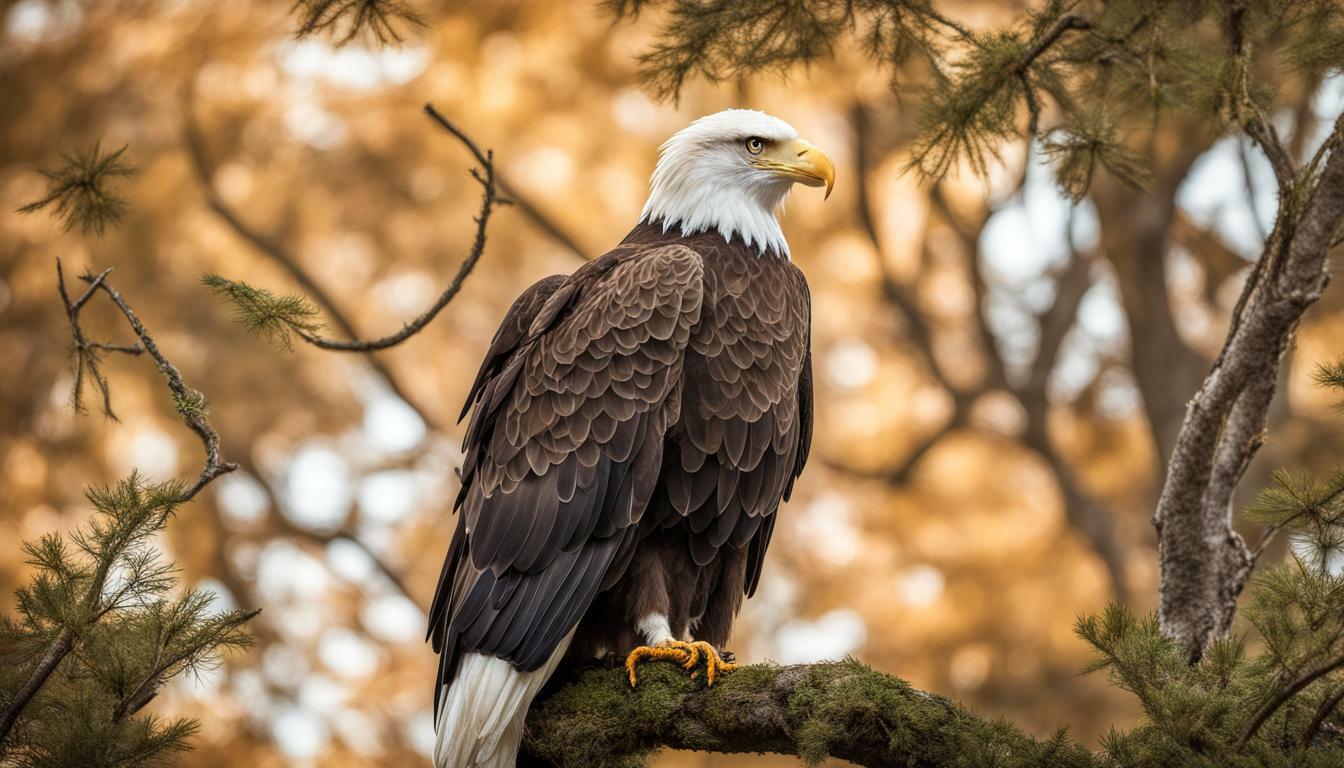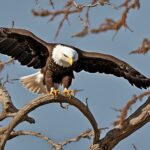If you’ve ever had the pleasure of observing a bald eagle in the wild, you may have wondered just how far these majestic birds can turn their heads. After all, their keen eyesight and hunting prowess rely heavily on their ability to spot prey from different angles. So, can bald eagles turn their heads 360 degrees? Let’s explore the fascinating world of bald eagles to find the answer.
Key Takeaways:
- Bald eagles are renowned for their impressive hunting abilities and keen eyesight.
- Their ability to turn their heads plays a crucial role in their hunting behavior.
- While bald eagles can’t turn their heads a full 360 degrees, they can rotate their necks up to 180 degrees in each direction.
The Basic Anatomy of a Bald Eagle
Before we dive into the question of whether bald eagles can turn their heads 360 degrees, let’s take a moment to examine their basic anatomy. Bald eagles are known for their impressive size and striking appearance, with wingspans of up to 7 feet and distinctive white heads and tails.
In addition to their striking appearance, bald eagles possess impressive physical characteristics that allow them to thrive in their natural habitats. Their bodies are lightweight yet strong, with feathers that offer insulation and protection from the elements.
| Physical Characteristics | Description |
|---|---|
| Wingspan | Up to 7 feet |
| Weight | Between 6 and 14 pounds |
| Coloring | Brown body with white head and tail |
| Beak | Yellow hook-shaped beak for tearing flesh |
| Talons | Sharp, curved talons for grasping prey |
Bald eagles also possess keen eyesight and powerful talons for hunting, making them one of the most skilled predators in their habitats. But what about their necks and ability to turn their heads? Let’s explore that next.
Neck Flexibility in Bald Eagles
One of the most fascinating aspects of bald eagles is their remarkable neck flexibility, allowing them to rotate their heads with impressive range of motion.
Like most birds, bald eagles have a relatively short neck, with only seven vertebrae. Despite this, bald eagles are known for their ability to turn their heads in almost a full circle, allowing them to scan their surroundings with ease.
Bald eagles accomplish this incredible feat thanks to their unique anatomy. Their vertebrae are specially adapted to allow for greater flexibility, and their neck muscles are incredibly strong and efficient.
Research has shown that bald eagles can rotate their heads up to 270 degrees, which is more than most other birds of prey. This means that they can look behind them without having to turn their bodies, allowing them to remain stealthy while hunting.
Interestingly, bald eagles have a “two-step” head movement when they turn their heads. First, they tilt their heads to the side to compensate for the placement of their eyes on the sides of their heads. Then, they rotate their heads to get a better view of their surroundings.
All in all, the impressive neck flexibility of bald eagles is a key part of their hunting behavior and survival in the wild.
How Far Can Bald Eagles Turn Their Heads?
Now that you have learned about the basic anatomy and neck flexibility of bald eagles, let’s dive into the specifics of their head rotation capabilities. Bald eagles are able to rotate their heads up to 270 degrees, which is an impressive feat considering the size and weight of their heads.
The neck bones of bald eagles are adapted to allow for this range of motion, with an increased number of vertebrae and unique joint structures. This flexibility is essential for their hunting behavior, as it allows them to scan their surroundings and spot potential prey without having to move their entire body.
While bald eagles cannot turn their heads a full 360 degrees like some owls, their range of motion is still impressive and vital to their survival in the wild.
Bald Eagles’ Vision Range
One of the most impressive features of bald eagles is their exceptional eyesight. With eyes that are about the same size as humans, but with much greater density of receptors, bald eagles can see incredibly well both near and far.
In fact, bald eagles have a visual acuity of about 20/5, which means that they can see an object at 20 feet that most people would need to be 5 feet away from to see clearly. This remarkable eyesight helps bald eagles detect prey from a great distance and make a precise calculation on how to catch it.
Their head movement plays a key role in their hunting abilities, as they can rotate their heads up to 270 degrees, allowing them to scan the environment around them for potential prey. With their eyes positioned forward, this rotation also helps them accurately judge the distance to their target.
When diving for prey, bald eagles use their sharp eyesight to track their prey as they descend downward at speeds of up to 100 mph. Their eyes are specially adapted to maintain a clear focus while moving at high speeds, even through the rush of wind and debris kicked up by their own movements.
Hunting Behavior of Bald Eagles
Now let’s talk about how the head movement of bald eagles contributes to their hunting behavior. Their exceptional vision combined with their neck flexibility makes them excellent hunters.
When hunting, bald eagles will perch in a tree or on a cliff overlooking a body of water. They can rotate their heads almost 180 degrees to scan the area for potential prey. Once they spot a fish, they will dive towards the water, reaching speeds up to 99 mph, and use their talons to grab the fish out of the water.
Not only are bald eagles skilled hunters, but they are also opportunistic ones. They will scavenge for food and steal prey from other birds if the opportunity presents itself.
Interestingly, bald eagles have been known to work together to hunt. In one instance, a group of bald eagles was observed herding a school of fish towards the shallow end of a river. The eagles then took turns diving to catch the fish, sharing the bounty among themselves.
Overall, the head movement of bald eagles plays a crucial role in their hunting abilities and contributes to their success as apex predators.
The Importance of Head Rotation in Survival
If you’ve been following along, you now know that bald eagles have an impressive range of motion in their necks and can rotate their heads up to 270 degrees. But, why is this ability so important for their survival?
Well, it all boils down to their hunting behavior. Bald eagles are apex predators and rely on their keen eyesight to spot prey from a distance. Once they’ve locked onto a potential meal, they’ll fly towards it, and use their incredible head rotation to keep their eyes locked onto the target as they swoop in for the kill.
Without their impressive head movement, hunting would be much more difficult for bald eagles. They would have to rely solely on flying in a straight line towards their prey and wouldn’t be able to adjust their gaze as they approached, making it harder to accurately pinpoint their target. This could result in missed opportunities and less successful hunts, ultimately affecting their survival.
Additionally, bald eagles must be alert to potential threats to their safety while hunting. With their flexible necks, they can quickly scan their surroundings for potential danger, such as other birds of prey or territorial animals.
All in all, the ability to rotate their heads is an essential tool in the arsenal of a bald eagle, aiding in their hunting success and survival in the wild.
Fascinating Facts About Bald Eagles
Aside from their impressive head movement abilities and hunting behavior, bald eagles possess several unique characteristics that make them fascinating creatures:
- Bald eagles are not actually bald. Their name comes from the word “piebald” which means “white-headed.”
- Bald eagles are one of the largest birds of prey in North America, with a wingspan of up to 7 feet.
- Bald eagles have 4 times better eyesight than human beings, enabling them to spot prey from a mile away.
- Bald eagles mate for life and will only look for a new partner if their mate dies.
- Bald eagles are capable of swimming, using their wings to paddle and their tail as a rudder.
- Bald eagles are known to steal food from other birds and animals, earning them the nickname “pirates of the sky.”
- Bald eagles are often used as a symbol of strength and freedom in American culture and history, appearing on the national emblem and seal.
In conclusion, bald eagles are not only impressive hunters with exceptional head movement abilities, but also possess a variety of unique characteristics that make them one of the most fascinating creatures in North America.
Conservation Efforts for Bald Eagles
Bald eagles, like many other species, face threats to their survival due to habitat loss, pollution, and human interference. However, due to their symbolic and cultural significance, there are several conservation efforts in place to protect these majestic birds.
The Bald and Golden Eagle Protection Act, passed in 1940, made it illegal to hunt, kill, possess, or sell bald eagles or their parts without a permit. This law helped to prevent the hunting and killing of bald eagles, which had significantly reduced their population levels.
Additionally, the Endangered Species Act of 1973 listed bald eagles as endangered, which led to their protection and the recovery of their populations. Due to successful conservation efforts, bald eagles were removed from the endangered species list in 2007 and are now classified as a species of “least concern” by the International Union for Conservation of Nature.
The U.S. Fish and Wildlife Service, along with various organizations and state agencies, continues to monitor and protect bald eagle populations. They conduct surveys, monitor nesting sites, and monitor the use of pesticides and other hazardous chemicals that can harm eagles and their habitats.
Additionally, efforts are being made to educate the public about the importance of protecting bald eagles and their habitats. By raising awareness and promoting conservation efforts, we can ensure the survival of these incredible birds for generations to come.
The Symbolism of Bald Eagles
If you live in the United States, you’ve likely seen images of bald eagles on everything from coins to flags to official seals. The bald eagle has been a symbol of America since the founding of the country, and its image represents freedom, strength, and majesty.
The bird’s symbolism dates back to early Native American cultures, where it was revered as a spiritual messenger between humans and the divine. The bald eagle was also seen as a symbol of power and courage, and feathers were often used in ritual dress and objects.
When Europeans arrived in America, they quickly recognized the beauty and power of the bald eagle. It was chosen as the emblem of the newly formed United States in 1782, and it remains one of the most iconic and recognizable symbols of the country.
The bald eagle’s symbolism extends beyond America, too. The bird is mentioned in the scriptures of many cultures around the world, from Ancient Greece to Norse mythology to Native American legends. In all of these cultures, the bird is seen as a powerful and respected creature.
Today, the bald eagle is still seen as a symbol of freedom, strength, and courage. It’s also a testament to the power of conservation efforts; the bird was nearly extinct in the mid-20th century due to habitat destruction and hunting, but conservation efforts have brought the species back from the brink. The bald eagle’s recovery is a symbol of hope and perseverance, and a reminder of our responsibility to protect the natural world.
Conclusion
So there you have it, the answer to the burning question: can bald eagles turn their heads 360 degrees? Although they may not be able to achieve a full 360-degree rotation, they do have an impressive range of motion in their necks, allowing them to quickly spot prey and navigate their environment.
Bald eagles are fascinating creatures, with unique physical and behavioral characteristics that make them a symbol of American strength and resilience. From their sharp talons and powerful beaks to their incredible eyesight and hunting abilities, there is much to admire about these majestic birds.
It’s important to remember, however, that bald eagles are also a vulnerable species, facing threats such as habitat destruction and environmental pollution. Thanks to conservation efforts, their populations have rebounded in recent years, but we must continue to protect them and their habitats for future generations.
Whether you’re a wildlife enthusiast, a history buff, or simply someone with a love of the great outdoors, learning about bald eagles can be a rewarding and enriching experience. So why not take some time to observe these incredible birds in their natural habitat, and appreciate all that they have to offer?
Can the Night Vision of Bald Eagles Explain Their Ability to Rotate Their Neck?
The exceptional bald eagles’ vision in the dark may shed light on their ability to rotate their neck. With highly developed night vision, these majestic birds can spot prey in dim light, allowing them to pursue their hunting instincts effectively. This heightened vision, combined with their flexible neck, enables bald eagles to swiftly locate and target their next meal, making them formidable predators in the wild.
FAQ
Q: Can bald eagles turn their heads 360 degrees?
A: Yes, bald eagles can turn their heads 360 degrees.
Q: What are the physical characteristics of a bald eagle?
A: The physical characteristics of a bald eagle include a distinctive head structure.
Q: How flexible are the necks of bald eagles?
A: Bald eagles have a remarkable range of motion in their necks and can rotate their heads.
Q: What is the maximum degree of rotation for bald eagles’ heads?
A: Bald eagles can achieve a significant range of head rotation.
Q: How does head movement contribute to a bald eagle’s vision range?
A: The ability to move their heads aids in bald eagles’ hunting abilities and expands their vision range.
Q: How does head movement assist in bald eagles’ hunting behavior?
A: The head movement of bald eagles helps them spot prey and engage in successful hunting behavior.
Q: Why is head rotation important for bald eagles’ survival?
A: Head rotation is vital for bald eagles’ survival as it allows them to adapt and thrive in their environment.
Q: What are some fascinating facts about bald eagles?
A: Bald eagles possess unique characteristics that make them fascinating creatures.
Q: What conservation efforts are in place to protect bald eagles?
A: There are various conservation efforts implemented to ensure the protection of bald eagles and their habitats.
Q: What is the symbolic significance of bald eagles?
A: Bald eagles hold great symbolism in American culture and history.











